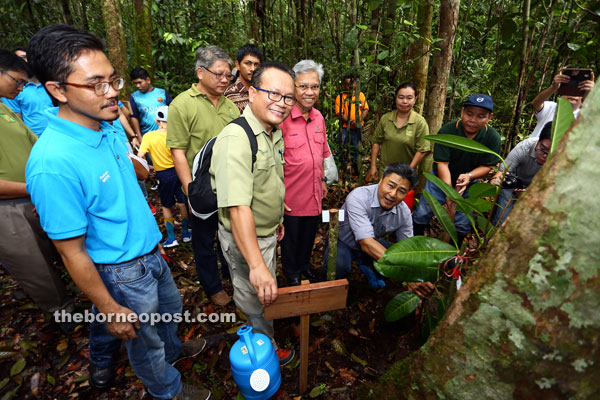
Sudarsono plants a tree sapling to mark the launch of the Fig Garden Project at Matang Wildlife Centre. — Photo by Muhammad Rais Sanusi
KUCHING: The survival of hornbills is closely linked to the quality of their environment, but this has been jeopardised by the clearing of large tracts of land for development.
The end result is dwindling hornbill population and fragmented forest areas across the state.
In this respect, Ministry of Resource Planning and Environment permanent secretary Datu Sudarsono Osman said the state government regarded the conversation of the state’s forests and wildlife as a major component under its conservation agenda.
“We have declared war against illegal logging, conducted studies for systematic conservation planning, undertaken the ‘Heart of Borneo’ (HoB) project, produced certification for Forest Management Unit (FMU) and opened up Totally Protected Areas (TPAs) for research through Rimba (Research for Intensified Management of Bio-rich Areas) Sarawak Project — amongst other programmes.
“Specifically, we have the Western Sarawak Hornbill Project, of which key components include habitat enhancement for the species. This paves the way to the establishment of Sarawak’s first ever ‘Fig Garden’ at Matang Wildlife Centre,” he said at the opening of the park near here yesterday, which was marked by the planting of 300 tree saplings by officials from relevant agencies, schoolchildren, honorary Wildlife Rangers, and members of Special Park Committee of Kubah National Park.
The 7.2-hectare Fig Garden is sited on a degraded patch of forest in Kubah National Park. The area is nourished by three streams — Sungai Batu, Sungai Entawa and Sungai Rayu.
The garden will have trees of both fig and non-fig species — an initiative aimed at rehabilitating and enriching the flora there.
Eventually, the tree species composition of the garden would be biased towards hosting fig trees.
Back on hornbills, Sudarsono called on all stakeholders to join forces in supporting the state’s conservation efforts.
Meanwhile, Sarawak Forestry Corporation (SFC) deputy chief executive officer Oswald Braken Tisen said the maintenance and activities for the Fig Garden project will be carried out in intervals, involving a number of stakeholders.
“If the project becomes successful, the same model would be replicated in other degraded areas especially those in the TPAs,” he said.
An initial batch of 300 saplings slated for planting yesterday comprised six fig species and eight other species — Jambu Laut, Ubah, Kubal, Dabai, Bintangor Laut, Bintagor Bukit, Selangan Batu and Engkabang Melapi.
The mixed-planting concept was adopted in order to provide suitable trees for nesting and food supply not only for hornbills, but also other species.
For the record, the Western Sarawak Hornbill Project covers 21 TPAs, encompassing 306,600 hectares over the western part of the state.
This vast area constitutes national parks (Tanjung Datu, Gunung Gading, Bako, Santubong, Kuching Wetlands, Kubah, Sampadi, Dered Krian, Bungo Range, Maludam, Ulu Sebuyau, Sedilu, Rajang Mangrove, Batang Ai and Gunung Lesung); nature reserves (Samajaya, Semenggoh, Wind Cave and Fairy Cave in Bau); and wildlife sanctuaries (Samusan and Lanjak Entimau).
